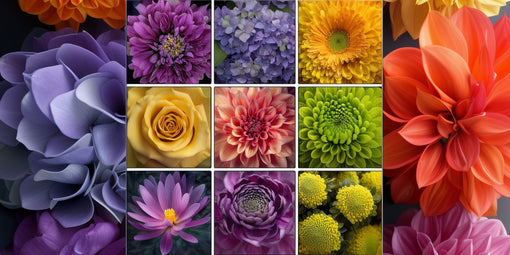
- Article published at:
Drawer menu
Gardening in the UK has never been more popular, and with rising interest in sustainability, biodiversity, and mental well-being, flower lovers are leading a quiet revolution in outdoor spaces. In 2025, British gardens are evolving — becoming more climate-conscious, nature-inclusive, and design-savvy than ever before.
Whether you're a seasoned grower or a first-time flower planter, these 2025 UK gardening trends reveal where the world of flowers is heading, and how you can bring these inspiring ideas to your own home — even in a small space.

As UK summers become hotter and drier, 2025 sees a big shift towards waterwise gardening. More gardeners are rethinking traditional borders and turning to drought-tolerant flowers that thrive with minimal watering.
This doesn't mean sacrificing beauty. Flowers like lavender, echinacea, yarrow, sedum, and verbena bonariensis are all resilient options that provide weeks of colour and attract pollinators too.
Expect more gravel borders, terracotta pots, and silver-leaved plants inspired by Mediterranean gardens. These features not only conserve water but also add a warm, contemporary feel to any outdoor area.
Gardeners are also replacing thirsty lawns with gravel, mulch, or flowering ground covers to reduce water consumption without losing greenery.

Bee-friendly planting has moved from trend to standard practice. In 2025, pollinator-first gardening is a top priority, with flower lovers designing their spaces to actively support biodiversity.
This includes:
Succession planting (for year-round nectar)
Choosing native wildflowers
Avoiding pesticides
Planting in clumps rather than rows
Favourites include foxgloves, catmint, cosmos, alliums, scabiosa, and single-flower dahlias. Not only do these flowers look stunning, but they also provide vital support to bees, butterflies, and hoverflies.
Even small balcony gardeners are getting involved, with window boxes designed specifically for pollinators — proving you don’t need acres of land to make an impact.
Forget flat lawns and rigid borders — meadowscaping is taking root. Inspired by natural meadows and rewilding projects, this trend is all about letting flowers grow freely and celebrating irregular, layered planting.
The modern British garden is moving away from perfectly trimmed hedges and towards informal, self-seeding flower patches. Think oxeye daisies waving next to poppies, or golden buttercups sharing space with ragged robin.
Meadowscaping can be achieved with wildflower turf, seed mixes, or by simply relaxing your mowing routine. It benefits local ecosystems while creating a soft, romantic aesthetic that changes through the seasons.

Climate resilience is no longer optional. Gardeners are building beds that can handle sudden frosts, long dry spells, and intense downpours.
Key strategies include:
Raised beds with good drainage
Mulching to retain moisture
Including hardy perennials and deep-rooted plants
Collecting rainwater in butts or barrels
In 2025, expect to see more diverse, layered planting that mimics nature. Taller plants like hollyhocks or delphiniums protect shorter ones, while mixed planting reduces the chance of disease or pest outbreaks.
Gardeners are also becoming more aware of plant hardiness zones, choosing varieties adapted to their specific local climate.

The beloved cottage garden style is having a revival — but it’s been updated. In 2025, it’s less about overly busy borders and more about structured informality.
Modern cottage gardens still feature classics like delphiniums, foxgloves, and roses, but now they’re paired with grasses, salvias, and pollinator-friendly herbs like thyme and chives.
Expect mixed textures, soft pastels, and edible flowers woven in. There’s also a shift towards picking gardens — areas designed for cutting and arranging fresh bouquets throughout the season.
Post-pandemic, mental health remains a key influence in garden design. Many flower lovers are creating quiet garden zones for meditation, reading, or reflection.
In 2025, there’s a rise in gardens with:
Scented plants (lavender, jasmine, mint)
Soothing colour schemes (blues, purples, whites)
Gentle sounds from wind chimes or fountains
Soft seating areas surrounded by calming flowers
Whether it's a single pot of daisies on a doorstep or a full sensory garden, the emotional power of flowers is being harnessed in a personal, meaningful way.

Sustainability is now a foundation of flower gardening — not a feature. In 2025, more people are gardening without peat, growing from seed, composting at home, and avoiding plastic.
There’s also growing interest in:
No-dig gardening
Permaculture principles
DIY flower food and compost teas
Using local, seasonal, and British-grown flowers
Whether you’re planting in pots or garden beds, flower lovers are becoming more conscious of their environmental footprint — and making better choices as a result.
Social media continues to influence garden aesthetics. Platforms like Instagram and Pinterest are full of flower colour palettes, floral flatlays, and mini-garden design ideas. However, in 2025, gardeners are bridging the gap between screen and soil.
Expect to see more people creating Pinterest-inspired cutting gardens, arranging flowers for home styling, and trying TikTok hacks for drying and preserving flowers.
But ultimately, the trend is clear: people want to feel connected to their space — and flowers are the perfect medium.
You don’t need to start from scratch to embrace 2025’s biggest ideas. Here’s how to make a start:
Choose climate-resilient flowers that suit your soil and sun levels
Replace part of your lawn with a wildflower patch
Use pollinator-friendly planting in beds, borders, or balcony boxes
Invest in a rain barrel to water your garden sustainably
Grow your own cut flowers to reduce imported blooms
Make time to simply enjoy your garden, even if it's just a few pots on a patio
The garden of 2025 is more thoughtful, expressive, and grounded than ever. It reflects a world where we value nature, resilience, and beauty — not just in grand gestures, but in everyday moments.
As we adapt our outdoor spaces to a changing world, flowers remain a symbol of joy, strength, and connection. Whether you’re growing native wildflowers, planting a drought-tolerant border, or simply placing a handpicked bouquet on your windowsill — you’re part of something bigger.